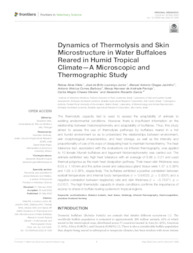Dynamics of thermolysis and skin microstructure in water buffaloes reared in humid tropical climate: a microscopic and thermographic study.
Dynamics of thermolysis and skin microstructure in water buffaloes reared in humid tropical climate: a microscopic and thermographic study.
Author(s): VILELA, R. A.; LOURENÇO JUNIOR, J. DE B.; JACINTO, M. A. C.; BARBOSA, A. V. C.; PANTOJA, M. H. DE A.; OLIVEIRA, C. M. C.; GARCIA, A. R.
Summary: The thermolytic capacity test is used to assess the adaptability of animals to existing environmental conditions. However, there is insufficient information on the relationship between histomorphometry and adaptability of buffaloes. Thus, this study aimed to assess the use of thermolysis pathways by buffaloes reared in a hot and humid environment so as to understand the relationships between environment, skin morphological characteristics, and heat storage, as well as the intensity and proportionality of use of its ways of dissipating heat to maintain homeothermy. The heat tolerance test, associated with the evaluations via infrared thermography, was applied to 10 female Murrah buffaloes and tegument histomorphometry was carried out. The animals exhibited very high heat tolerance with an average of 9.66 ± 0.21 and used thermal polypnea as the main heat dissipation pathway. Their mean skin thickness was 6.03 ± 1.16 mm and the active sweat and sebaceous gland tissue were 1.57 ± 0.38% and 1.08 ± 0.39%, respectively. The buffaloes exhibited a positive correlation between eyeball temperature and internal body temperature (r = 0.84523, p < 0.0001) and a negative correlation between respiratory rate and skin thickness (r = -0.73371, p = 0.0157). The high thermolytic capacity in shade conditions confirms the importance of access to shade in buffalo rearing systems in tropical regions.
Publication year: 2022
Types of publication: Journal article
Observation
Some of Embrapa's publications are published as ePub files. To read them, use or download one of the following free software options to your computer or mobile device. Android: Google Play Books; IOS: iBooks; Windows and Linux: Calibre.
Access other publications
Access the Agricultural Research Database (BDPA) to consult Embrapa's full library collection and records.
Visit Embrapa Bookstore to purchase books and other publications sold by Embrapa.

